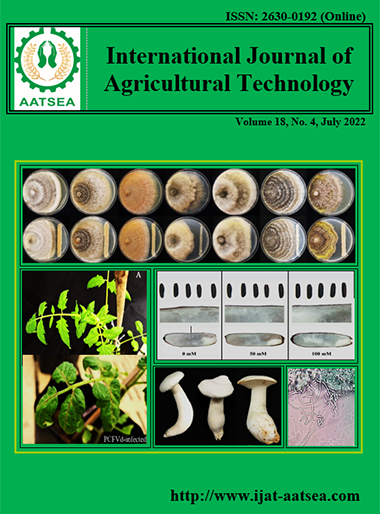Magnitude of heterosis for some quantitative traits in aromatic rice
Main Article Content
Abstract
Measurement of heterosis is one among the strategies to achieve the targets in crop improvement, and serves as a guide in making sound decisions in selecting the best hybrids which could be commercially exploited and selected the desirable recombinants in the succeeding generations to develop new lines. The best heterotic effects on maturity was exhibited by CL 1 x P 20, CL 1 x G 12, CL 1 x G 28 and CL 1 X G 10 as shown by their highly significant negative MP heterosis values of -6.2%, -6.85%, -7.41% and -9.01%, respectively and BP heterosis with -8.01%, -7.41%, -10.06% and -9.97%. Heterosis in desirable direction was noted on plant height for Jasmine x P20 over its BP (-8.83%). Heterotic effects on panicle length was highly significantly differed and positively over MP and in maximum on Jasmine x G 28 ( 76.87%) and heterobeltiosis over the better parent in Kasturi x P 20 (21.13%). The positively significant MP heterosis for spikelet fertility was shown by CL 1 x G 28 (18.77%), Pandan x P 20 (18.39%), CL 1 x G 12 (17.40%), Pandan x G10 (16.76%) and CL 1 x P 20 (6.20%). Most of the crosses had highly significant recorded in positive MP (2.58 to 34.55%) and BP heterosis (6.00 to 30.12%) for 1000 seed weight. CL 1x G 10, CL 2 x G 12 and Pandan x P 20 revealed highly significant and positive MP (138.55%, 88.90% and 81.23%) and BP heterosis (66.00%, 125.36% and 48.60%) for yield. CL 1 x G 10, CL 2 x G 12 and Pandan x P 20 would be forwarded in the next generation for identification and selection of transgressive segregants for yield; CL 1 x P 20, CL 1x G 12, CL 1 x G 20 and CL 1x G 10 for earliness; and Jasmine x P 20 for dwarfness or shortness
Article Details

This work is licensed under a Creative Commons Attribution-NonCommercial-NoDerivatives 4.0 International License.
References
Abdel-Moneam, M. A., Sultan M. S., Hammoud S. A., Hefena, A. G., Barutçular, C. and EL Sabagh, A. (2016). Studies on heterosis for qualitative and quantitative traits in rice. Journal of Animal and Plant Scienes, 30:4736-474.
Bagheri, N. and Babaeian Jelodar, N. (2010). Heterois and combining ability analysis for yield and yiel-related traits in hybrid rice. International Journal of Biology, 2:222-231.
Borah, P., Sarma, D. and Hazarika, G. N. (2017). Magnitude of heterosis for yield and its components in hybrid rice. International Journal of Agricultural Science and Research, 7:209-216.
Jarwar, D, Dela Cruz, Q. D. and Junejo, G. S. (2013). Heterosis of some yield and its related characters in aromati rice (Oryza sativa L.) (PhD. Thesis). Central Luzon State University, Philippines.
Kempthorne, O. (1957). An Introduction to Genetic Statistics. New York: John Wiley and Sons, Inc.
Khush, G. S. (2005). What it will take to feed 5.0 billion rice consumers in 2030. Plant Molecular Biology, 59:1-6.
Khush, G. S. and Brar, D. S. (2002). Biotechnology for rice breeding: Progress and potential impact. Proceeding of the 20th Session of the International Rice Commission. Retried from http://www.fao.org/docrep/006/Y4751E/y4751e04.htm.
Kumar, Aditya, Singh, S. and Singh, S. P. (2012). Heterosis for yield and yield components in basmati rice. Asian Journal of Agriultural Research, 6:21-29.
Nuruzzaman, M., Alam M. F., Ahmed, M. G., Shohael, M. K., Biswas, M. K., Amin, M. R. and Hosaai, M. M. (2002). Studies on parental variability and heterosis in rice. Pakistan Journal of Biological Sciences, 5:1006-1009.
Santos Kumar, N. K., Singh, R. K., Sing, S. K., Nilanjaya, C. K. and Kumar, A. (2017). Heterosis studies for various morpholgical traits of rice under drought condition. International Journal of Current Microbiology and Applied Sciences, 6:507-521.
Tiwari, D. K., Pandey, P., Giri, S. P. and Dwivedi, J. L. (2011). Heterosis studies and its components in rice hybrids using CMS system. Asian Journal of Plant Sciences, 10:29-42.
Veeresha, B. A., Hanamaratti, N. G. and Salimath, P. M. (2015). Heterosis and combining ability studies for yield and productivity traits in rice: A review. International Journal of Current Agricultural Research, 4:120-126.
Virmani, R. S., Viraktamath, B. C., Casal, C. L., Toledo, R. S., Lopez, M. T. and Manalo, J. O. (1997). Hybid rice manual. International Rice Research Institute, Philippines.
Virmani, S. S., Young, H. P., Moon, I. K., and Fin, J. C. (1991). Increasing rice yields through exploitation of heterosis. International Rice Research Institure, Philippines. pp.12.


